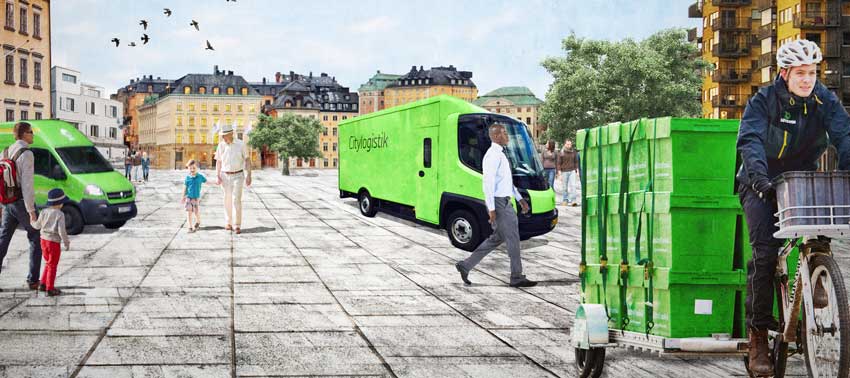Decarbonising last-mile freight transport
Freight transport is a particularly tricky sector to decarbonize. The sector is extremely fossil-fuel dependent today, with the vast majority of freight being transported by road. Freight is necessary to deliver the goods and services that we require as well as handle our waste, but in most cases is a “hidden” sector that is undervalued and for which there is low willingness to pay.

In our consumerist society, we expect products to be delivered and waste collected fast and efficiently, resulting in impacts on carbon emissions since lower speed modes in supply chains are less carbon intensive.
Urban freight transport
In a city, about 30% of transport emissions can be attributed to the freight sector. This includes delivery vehicles, waste collection, and transport of building materials. In the Nordic countries (Denmark, Finland, Iceland, Norway and Sweden), many cities are growing and densifying and there is a large amount of building work ongoing. Growth in urban dwelling is expected to result in an increased share of freight from total traffic and CO2 emissions. This is because there are strong policies to decrease or stabilize passenger transport, while more people will result in more freight as consumption (and waste) is expected to remain constant or increase. E-commerce is a sector that is particularly relevant in this case, as it is expected to increase and results in more and trickier logistics due also to returns.
What’s going on in the Nordics?
Over the Nordic countries, there is no single overarching initiative that focuses on urban freight transport decarbonisation, but there are several individual (and national) examples. The freight transport sector is run almost exclusively by the private sector which can make it problematic to decarbonize the sector since this will only been done if there is a business opportunity in decarbonising. The public sector has a crucial role to play in setting the appropriate framework conditions that make it possible to support low-carbon initiatives without skewing competition or negatively affecting business. Some Nordic cities such as Copenhagen, Gothenburg, Oslo and Stockholm are European and world leaders in these topics.
Some examples from the Nordics
CLOSER is a Swedish platform that brings together different actors working in the freight sector in Sweden. They coordinate the programme Triple F (Fossil Free Freight) which is financed with 290 million SEK over 12 years by the Swedish Transport Administration (Trafikverket). The programme coordinates research and innovation which supports the shift to a de-carbonised freight transport sector.
Within several projects in Sweden, urban freight terminals or microterminals are introduced, with delivery done by zero-emission vehicles. This is also the case in other Nordic countries including in Oslo with the Oslo City Hub run by DB Schenker. What is particularly interesting with this example is that the City of Oslo has clear goals for transport de-carbonisation, and the clear long-term policy helps companies support the transition to zero-emission vehicles because a shift to zero-emission means that private actors can compete in the market in the future. Creating business models for urban freight solutions is the focus of much research in the area, and the public authority plays an important role once again in creating the right framework conditions.
There are more and more electric freight vehicles available on the market including from Einride and Volvo in Sweden, but also many types of new cargo bikes. Cargo bikes can be particularly useful in areas which are densely built with appropriate infrastructure for cycling as they provide a highly competitive solution compared to larger vehicles (for example in Copenhagen but also other cities).
What needs to be done
At the basis of any urban freight transport decarbonisation initiative are four things: (1) cooperation; (2) a functioning business model; (3) innovative procurement and/or regulation; and (4) low-emission vehicles.
We want with this article to highlight the importance of last mile freight transport as well as a taste of ongoing initiatives in the area in the Nordics. What is clear is that there is work being done, but there is a need for cooperation both nationally and internationally. The public sector has a crucial role in setting the right framework conditions for the private sector to be able to create sustainable business models, and the zero-carbon solutions need to be tried and tested under local conditions in order to work.
Last mile freight is part of a long chain, and one of the barriers to decarbonisation of the sector is increased consumption as well as expectancy of fast deliveries (which make it difficult to shift away from road transport). Measures to de-carbonise the freight sector should also focus on decreasing consumption and waste, and linking to the circular economy.
What’s needed are frameworks to help public authorities to develop appropriate long-term policies and which work across the Nordics (and beyond). The need to develop coherence across borders is important since many freight companies work internationally, and coherent frameworks allow for the creation of solutions that can be applied in more than one location. Additionally, testing of solutions, creation of new partnerships, business models and testing and roll-out of new vehicles needs to be done to make sure that solutions work in practice and can be applied also elsewhere.
Want to find out more?
Last mile freight is a priority area for Climate-KIC under the Urban Transitions Theme. To find out more about work in this area in the Nordics, please contact:
Anna Clark, +46 10 456 56 23, Trivector Traffic AB or Anders Vestergaard Jensen, +45 268 368 98, Climate-KIC Nordic

